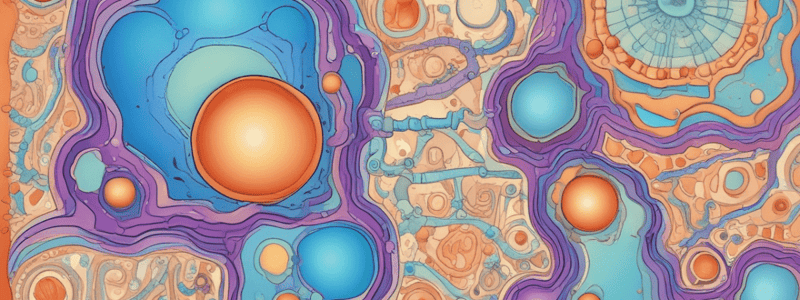Podcast
Questions and Answers
Which glucose transporter has a high Km and is involved in regulating blood glucose levels?
Which glucose transporter has a high Km and is involved in regulating blood glucose levels?
- GLUT1
- GLUT2 (correct)
- GLUT4
- GLUT3
What is the effect of insulin on GLUT4 in muscle and adipose cells?
What is the effect of insulin on GLUT4 in muscle and adipose cells?
- Insulin increases the amount of GLUT4 in the plasma membrane (correct)
- Insulin only affects GLUT2
- Insulin has no effect on GLUT4
- Insulin decreases the amount of GLUT4 in the plasma membrane
What type of ion channels are gated by acetylcholine?
What type of ion channels are gated by acetylcholine?
- Ligand-gated channels (correct)
- Mechanically-gated channels
- Gap junctions
- Voltage-gated channels
What is the characteristic of GLUT3?
What is the characteristic of GLUT3?
What is the effect of insulin on glucose uptake in muscle and adipose cells?
What is the effect of insulin on glucose uptake in muscle and adipose cells?
What is the location of GLUT4 before insulin stimulation?
What is the location of GLUT4 before insulin stimulation?
Which of the following molecules can freely cross the membrane by simple diffusion?
Which of the following molecules can freely cross the membrane by simple diffusion?
What is the primary function of the Na+/K+-ATPase membrane pump?
What is the primary function of the Na+/K+-ATPase membrane pump?
Which of the following is NOT an example of facilitated diffusion?
Which of the following is NOT an example of facilitated diffusion?
What is the relationship between the partition coefficient of a solute and its rate of diffusion?
What is the relationship between the partition coefficient of a solute and its rate of diffusion?
What is the function of the GLUT1 glucose transporter?
What is the function of the GLUT1 glucose transporter?
What is the primary difference between passive transport and facilitated diffusion?
What is the primary difference between passive transport and facilitated diffusion?
What is the unit of measurement for the partition coefficient of a solute?
What is the unit of measurement for the partition coefficient of a solute?
Which of the following is an example of secondary active transport?
Which of the following is an example of secondary active transport?
What is the relationship between the Km of a transporter and its affinity for the solute?
What is the relationship between the Km of a transporter and its affinity for the solute?
What is the primary difference between gated ion channels and facilitated diffusion?
What is the primary difference between gated ion channels and facilitated diffusion?
What is the main function of the Na+/K+ pump?
What is the main function of the Na+/K+ pump?
What type of transport is used by the Na+/K+ pump?
What type of transport is used by the Na+/K+ pump?
What is the role of the ATP hydrolysis in the Na+/K+ pump?
What is the role of the ATP hydrolysis in the Na+/K+ pump?
What is the purpose of the sodium-calcium exchanger?
What is the purpose of the sodium-calcium exchanger?
What is the role of the SGLUT in glucose absorption?
What is the role of the SGLUT in glucose absorption?
What is the effect of digitoxin on the Na+/K+ pump?
What is the effect of digitoxin on the Na+/K+ pump?
What is the role of CFTR in cells?
What is the role of CFTR in cells?
What is the effect of cystic fibrosis on chloride transport?
What is the effect of cystic fibrosis on chloride transport?
What is the purpose of oral rehydration therapy in cholera treatment?
What is the purpose of oral rehydration therapy in cholera treatment?
What type of transport is used by the sodium-calcium exchanger?
What type of transport is used by the sodium-calcium exchanger?
Flashcards are hidden until you start studying
Study Notes
Membrane Transport
- Membranes are selectively permeable, blocking the passage of most hydrophilic molecules into cells and organelles.
- Small uncharged or hydrophobic molecules can freely cross the membrane by simple diffusion along their concentration gradients.
- Charged polar molecules require specialist proteins (pumps, transporters, pores) to cross the membrane.
Mechanisms of Transport
- Simple Passive Transport / Diffusion: solutes move down a concentration gradient crossing the membrane, and the rate of diffusion depends on the partition coefficient of the solute.
- Facilitated Diffusion: solutes move down a concentration gradient crossing the membrane, requiring a membrane protein (ion channel); examples include Cl-/HCO3- channel in erythrocytes, aquaporin (water channel), and GLUT glucose transporters.
- Gated Ion Channels: ion channels that allow facilitated diffusion, selective for different ions (K+, Na+, Ca2+), open or close in response to a stimulus (e.g., ligand-gated or voltage-gated).
- (Primary) Active Transport: solutes move against a concentration gradient, requiring a membrane protein and energy from ATP hydrolysis; example: Na+/K+ pump (Na+/K+ ATPase) in the plasma membrane.
- Secondary Active Transport: pre-established gradient is used to drive transport of solutes against a gradient, with ATP hydrolysis used to establish the primary gradient; examples include Na+/glucose cotransporter (SGLUT) and Na+/Ca2+ cotransporter.
Na+/K+ Pump
- Na+/K+ pump (Na+/K+ ATPase) is a primary active transport mechanism that uses energy from ATP hydrolysis to maintain a [Na+] and [K+] gradient across the plasma membrane.
- The pump consists of a tetramer (α2β2) and uses ATP hydrolysis to phosphorylate the pump, causing a conformational change that drives the transport of Na+ and K+.
GLUT Family
- The GLUT family of glucose transporters (GLUT1-4) are involved in facilitated diffusion of glucose into cells.
- Each GLUT has a specific location, function, and affinity for glucose, with GLUT4 being regulated by insulin to increase glucose uptake in muscle and adipose tissue.
Clinical Considerations
- Digitoxin: cardiac glycosides (digitoxin and digoxin) inhibit the Na+/K+ pump, leading to an increase in [Na+] and a loss of the Na+ gradient, resulting in increased [Ca2+] and contraction in heart muscle.
- Ouabain: cardiac glycosides (ouabain) inhibit the Na+/K+ pump by blocking the binding of K+, also leading to increased [Na+] and [Ca2+] in heart muscle.
- CFTR: cystic fibrosis transmembrane conductance regulator (CFTR) is an ATP-gated ion channel that regulates the movement of chloride ions, which in turn regulates water movement; mutations in CFTR cause cystic fibrosis.
- Cholera Treatment: oral rehydration therapy includes high glucose concentration (~110 mM) which drives Na+ (and consequently Cl- and H2O) uptake into cells via SGLUT, treating cholera caused by Vibrio cholerae.
Studying That Suits You
Use AI to generate personalized quizzes and flashcards to suit your learning preferences.




